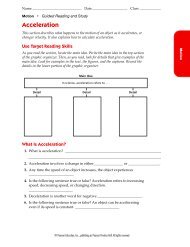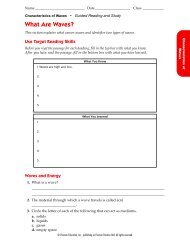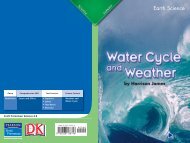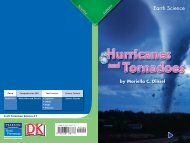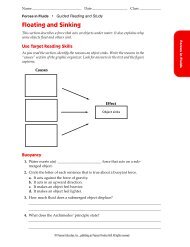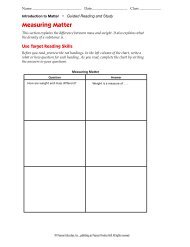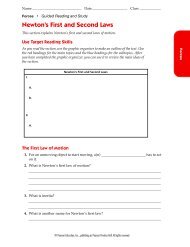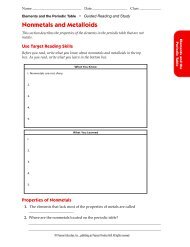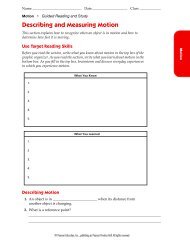Temperature, Thermal Energy, and Heat - district87.org
Temperature, Thermal Energy, and Heat - district87.org
Temperature, Thermal Energy, and Heat - district87.org
You also want an ePaper? Increase the reach of your titles
YUMPU automatically turns print PDFs into web optimized ePapers that Google loves.
<strong>Thermal</strong> <strong>Energy</strong> <strong>and</strong> <strong>Heat</strong><br />
Name ____________________________ Date ____________________ Class ____________<br />
<strong>Thermal</strong> <strong>Energy</strong> <strong>and</strong> <strong>Heat</strong><br />
■<br />
Guided Reading <strong>and</strong> Study<br />
<strong>Temperature</strong>, <strong>Thermal</strong> <strong>Energy</strong>, <strong>and</strong> <strong>Heat</strong><br />
This section describes the three common temperature scales <strong>and</strong> explains how<br />
temperature, thermal energy, <strong>and</strong> heat are related.<br />
Use Target Reading Skills<br />
This section explains how temperature, thermal energy, <strong>and</strong> heat are related.<br />
As you read the section, compare <strong>and</strong> contrast temperature, thermal energy,<br />
<strong>and</strong> heat by completing the graphic organizer. The completed graphic<br />
organizer can be used to see the ways in which temperature, thermal energy,<br />
<strong>and</strong> heat are similar <strong>and</strong> different.<br />
<strong>Energy</strong> Measured<br />
Units<br />
<strong>Temperature</strong><br />
<strong>Thermal</strong> <strong>Energy</strong><br />
<strong>Heat</strong><br />
<strong>Temperature</strong><br />
1. Is the following sentence true or false The faster that particles of matter<br />
move, the more kinetic energy they have. ________________________<br />
2. What is temperature<br />
________________________________________________________________________<br />
________________________________________________________________________<br />
________________________________________________________________________<br />
3. Which particles are moving faster, the particles in a mug of hot cocoa or<br />
the particles in a glass of cold chocolate milk<br />
________________________________________________________________________<br />
________________________________________________________________________<br />
________________________________________________________________________<br />
© Pearson Education, Inc., publishing as Pearson Prentice Hall. All rights reserved.
Name ____________________________ Date ____________________ Class ____________<br />
<strong>Thermal</strong> <strong>Energy</strong> <strong>and</strong> <strong>Heat</strong><br />
■<br />
Guided Reading <strong>and</strong> Study<br />
<strong>Temperature</strong>, <strong>Thermal</strong> <strong>Energy</strong>, And <strong>Heat</strong> (continued)<br />
4. What are the three common scales for measuring temperature<br />
a. _____________________________ b. _____________________________<br />
c. _____________________________<br />
5. The most common temperature scale in the United States is the<br />
________________________ scale.<br />
6. The temperature scale used in most of the world is the<br />
________________________ scale.<br />
7. The temperature scale commonly used in physical science is the<br />
________________________ scale.<br />
8. What are the intervals on the Fahrenheit scale called<br />
________________________________________________________________________<br />
9. Which scale is divided into 100 equal parts between the freezing <strong>and</strong><br />
boiling of water ________________________<br />
10. What is the temperature called at which no more energy can be removed<br />
from matter ________________________<br />
11. Complete the following table.<br />
<strong>Temperature</strong> Scales<br />
Scale Absolute Zero Water freezes Water boils<br />
Fahrenheit −460°<br />
−273° 100°<br />
0 273<br />
<strong>Thermal</strong> <strong>Energy</strong> <strong>and</strong> <strong>Heat</strong><br />
12. The total energy of the particles in a substance is called its<br />
________________________ energy.<br />
13. Circle the letter of each sentence that is true of thermal energy.<br />
a. <strong>Thermal</strong> energy partly depends on the temperature of a substance.<br />
b. <strong>Thermal</strong> energy partly depends on the scale used to measure the temperature<br />
of a substance.<br />
c. <strong>Thermal</strong> energy partly depends on how the particles of a substance<br />
are arranged.<br />
d. <strong>Thermal</strong> energy partly depends on the number of particles of a substance.<br />
© Pearson Education, Inc., publishing as Pearson Prentice Hall. All rights reserved.
<strong>Thermal</strong> <strong>Energy</strong> <strong>and</strong> <strong>Heat</strong><br />
Name ____________________________ Date ____________________ Class ____________<br />
<strong>Thermal</strong> <strong>Energy</strong> <strong>and</strong> <strong>Heat</strong><br />
■<br />
Guided Reading <strong>and</strong> Study<br />
Specific <strong>Heat</strong><br />
14. What is a substance’s specific heat<br />
________________________________________________________________________<br />
________________________________________________________________________<br />
________________________________________________________________________<br />
15. What is the unit of measure for specific heat<br />
________________________________________________________________________<br />
________________________________________________________________________<br />
16. Materials with a high specific heat can absorb a great deal of thermal<br />
energy without a great change in ________________________.<br />
17. The energy gained or lost by an object is related to which of the<br />
following Circle the letter of the terms that answer the question.<br />
a. mass<br />
b. volume<br />
c. specific heat<br />
d. change in temperature<br />
18. What is the formula you can use to calculate thermal energy changes<br />
________________________________________________________________________<br />
________________________________________________________________________<br />
© Pearson Education, Inc., publishing as Pearson Prentice Hall. All rights reserved.



